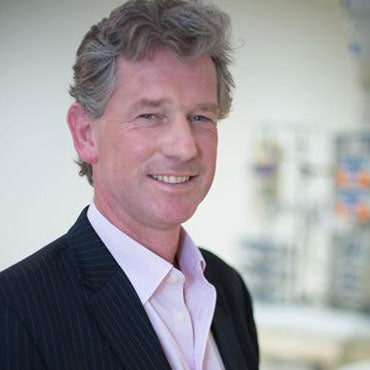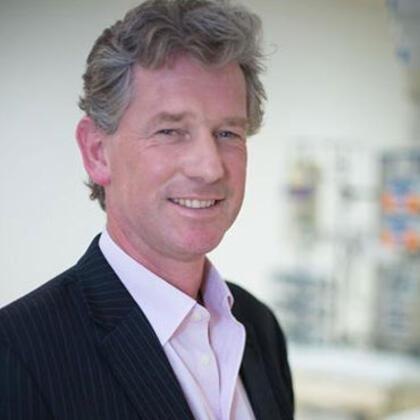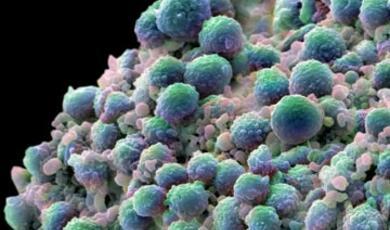Xtreme Everest: Taking Medicine from Mountainside to Bedside
Share
- Details
- Text
- Audio
- Downloads
- Extra Reading
In 2007, a team of doctors and scientists ascended to the roof of the world to understand more about how we adapt to high altitude - and why some of us adapt better than others. The Caudwell Xtreme Everest expedition was central to a fifteen year programme of research aiming to understand how humans adapt to low oxygen levels when critically ill. The researchers believe that changes in human physiology that allow some humans to climb the highest mountains on earth, may also be of benefit when oxygen levels in the body are low because of illness. This story combines high science with exceptional human endeavour.
Download Text
21 March 2017
Xtreme Everest:
Taking Medicine from Mountainside to Bedside
Professor Mike Grocott
Ten years ago, give or take a couple of weeks, I stood on the summit of Everest as the leader of a medical research expedition: Caudwell Xtreme Everest. It was a bitter-sweet moment. Sweet for the extraordinary panorama, the companionship of old friends in an amazing place, and the nearing of the end of a three-year journey (or so I thought); tinged with sadness for lost friends, and concern for the long descent and the safety of our large extended team. We left for Nepal on St Patrick’s Day 2007, and finally left base-camp with our experiment completed at the beginning of June that year. My aim is to explain why we went to Everest, how we achieved our goal, and what we have learned. I will start by setting the scene towards the end of the expedition, high on the mountain, shortly before our planned summit climb.
Usha Bista, a young Nepalese climber, has just been found high on the South-East ridge of Everest, alone, barely conscious, hypothermic and almost certainly badly frostbitten: a situation commonly thought to be un-survivable. Dave Hahn, an American guide, and members of our team, have initiated a rescue and she is brought down to the South Col of Everest where our team are preparing to head for the summit, having completed our scientific studies. It is late afternoon and Usha is in real peril. Night is closing in, and the prospect of a rescue down off the mountain to definitive medical treatment in Kathmandu seems very remote.
Mount Everest, the highest point on the surface of the earth, stands on the Nepal-Chinese border. It rises 8848 metres (29028 feet) above sea-level, and for reasons of apparent coincidence, the summit of Everest sits right at the limit of tolerance of humans to hypobaric hypoxia: the reduction of oxygen that occurs due to low pressure at high altitude.
The ascent of Everest was first attempted from the North and for many years this was an exclusively British pastime. During the 1920s and 1930s, successive British expeditions sponsored by the Royal Geographical Society and the Alpine Club came tantalizingly close the summit of the mountain, both with and without supplemental oxygen. In 1950, China invaded Tibet and the northern approach to Everest was closed. Nepal, previously a very private nation that had restricted foreigners to the Kathmandu valley, opened up the countryside and climbers approached the southern slopes of Everest for the first time. Everest was rapidly reconnoitered and by 1952 the Swiss climber Raymond Lambert had succeeded in climbing high on the southeast ridge with Sherpa Tenzing Norgay. The following spring a British Expedition succeeded in reaching the summit and Edmund Hillary and Tenzing Norgay became instantly and forever famous for being the first humans to reach the summit of Earth’s tallest mountain. One question was answered: ‘could humans ascend to the highest point on the surface of the earth?’ Whether they could achieve this feat without supplemental oxygen remained unknown. It took nearly 25 years more for this answer to come. In the spring of 1978, Reinhold Messner and Peter Habeler, two German-speaking Italians from the Tyrol, reached the summit of Everest without recourse to assistance from supplemental oxygen. In doing so, they became the 64th and 65th individuals to climb Everest: to this day, only about 4% of the several thousand people who have climbed Everest have done so without help from supplemental oxygen. In the winter, when the barometric pressure is a little lower, and there is just a little less oxygen available, this feat is even less common. Oxygen is at the centre of this story of human endeavour and our relationship with the highest point on the surface of our planet.
Barometric pressure falls with increasing altitude whilst the fraction of the atmosphere that is oxygen remains constant. As a consequence, the amount of oxygen per unit volume of air decreases in proportion to the fall in pressure with altitude. At the height of Everest Base Camp (5300 metres, 18000 feet), the available oxygen is roughly halved; at the summit of Everest it is reduced to a third of sea-level values. From experiments conducted on military aviators during the Second World War, we know that healthy humans exposed to such low levels of oxygen rapidly lose consciousness (within 1-2 minutes) and that death follows shortly afterwards unless supply of oxygen is restored. On the other hand, we know that, given sufficient time to adapt, it is possible for humans to tolerate such low levels of oxygen through a series of changes we refer to as acclimatisation.
Classically, these changes have been thought of as being about maintaining an adequate supply of oxygen to the tissues: the cells of the brain, heart, muscles and other organs that keep us alive. Consistently observed patterns of acclimatisation clearly serve to achieve this goal: breathing becomes brisker, the number of red blood cells increases, and the heart pumps more vigorously. All of these changes, and many more, serve to increase the oxygen content of the blood and intuitively this seems a rational approach to coping with an environmental lack of oxygen. However, counter-intuitively, it seems that these changes do not explain what how acclimatisation works. If this description provided a full explanation of how adaption to low oxygen levels is achieved, then it would be expected that those individuals with the briskest responses would perform the best at altitude and those with limited responses would perform less well. This is not the case. Physical fitness is a perfect example.
So what was it about Messner and Habeler that enabled them to achieve their goal? Clearly, the vision and ambition to take on the challenge were important. The psychological strength to remain resilient throughout the climb was critical; but what of physiology? What physical characteristics allowed these two extraordinary individuals to succeed? In the late 70s and early 80s Messner and Habeler were intensively studied by the best high altitude physiologists of the day. The most remarkable finding of all this investigation was how unremarkable they were (from a biological perspective). Almost every physiological variable one could suggest that might be linked to improved tolerance of hypoxia was evaluated in these two “supermen”, and in no respect where they found to be exceptional. Nothing apparently explained their extraordinary performance. Almost as remarkable, is the observation that the disabilities and impairments experienced by climbers at altitude are not explained by lack of oxygen in the blood. For example, at Everest base camp, although the ability to perform physical exercise is reduced by one third, the amount of oxygen in the blood is actually normal or increased due to the substantial increase in the level of the oxygen carrying red blood cells. All this prompted us to ask the question: what does explain the remarkable differences between individuals? Why can some people climb Everest without additional oxygen whilst others struggle to reach Everest base-camp, nearly 4000 metres below?
Caudwell Xtreme Everest was a medical research expedition to extreme altitude. Our aim was to learn more about the physiology of critically ill patients through the study of healthy humans ascending high mountains. The expedition stands at the centre of a programme of fieldwork in the mountains and laboratory work at sea level with a single scientific goal: to understand the differences between individuals in their ability to tolerate low oxygen levels. Many of the Xtreme Everest team care for critically ill patients in their “day jobs” and the ambition to improve the care of our patients is at the heart of the project: addressing the challenge of why some humans tolerate very low oxygen levels with apparent ease, whilst other struggle, has been the Xtreme Everest mission for more than 15 years.
Undertaking such experiments at extreme altitude is a massive challenge, technically, logistically and personally. To overcome the technical challenges, we tested all our equipment under the conditions we expected to find high on Everest to ensure that all measurements would be accurate and reliable. To overcome the logistical challenge, a team of five was dedicated to the efficient and effective disposition of equipment across seven laboratories separated by hundreds of kilometres and thousands of vertical metres: twenty-six metric tonnes of equipment was shipped to Nepal in more than 500 containers, all described by a master-spreadsheet containing more than half a million items. The personal challenge was faced through meticulous preparation over two previous Himalayan expeditions during which 18 climbers summited peaks over 8000 metres. At the end of all this we had a team and a plan that we thought we could take to Everest with a reasonable expectation of successful completion of our scientific goals. Caudwell Xtreme Everest also involved us in activities that were very unfamiliar to us as doctors and climbers. For the project to succeed we had to raise more than one and a half million pounds and attract numerous sponsors. We learned, with much help, about marketing, media and money and we were incredibly fortunate to attract a group of sponsors who remained loyally supportive throughout. Our “title” sponsor, John Caudwell, trekked with us all the way to basecamp as a subject of the experiments and then went on to climb higher on the surrounding peaks. British and international companies large and small supported us incredibly generously and our professional grant giving bodies were both kind and brave to back such an unusual project.
So what did we do? Two hundred volunteer were studied at sea level before trekking to Everest base-camp during their annual leave: each of them contributed not only their time and effort to the studies, but also kindly donated to support the research. Sixty investigators took three months or more out of their regular jobs to deliver the study, and in some cases climb high on Everest in the process. Two film crews followed us every step of the way from our laboratories at sea level in London, to the Nepali capital Kathmandu (1300 metres), to the Sherpa capital Namche Bazaar (3450 metres), via the tiny mountain village of Pheriche (4250 metres) to Everest Base Camp at (5300 metres, 18,000 feet). In each place as we went higher, we set-up and ran state-of–the-art laboratories working off 240 volt AC power from generators and solar and were able to collect the same complex and comprehensive physiological measurements that we did at sea-level. The result is a unique database of physiological data linked to a “BioBank” of samples that continues to yield important scientific insights.
So what did we find? Firstly, we confirmed previous work that I have explained above: changes in the simple physiological variables linked to increasing transport of oxygen within the body did not explain the changes in performance we observed at altitude. Strikingly, there was no link between the amount of oxygen in the blood, and the capacity of the body to consume oxygen at high altitude. Counter intuitively, the fittest participants were worst affected by exposure to low oxygen levels, even though their fitness was defined by the capacity to transport large amounts of oxygen at sea level. Second, we demonstrated that the smallest blood vessels in the body were functioning unusually, and probably in a harmful way. This functional impairment in the “microcirculation” might in part explain the mismatch between the amount of oxygen carried in the large blood vessels, and the capacity to use that oxygen to exercise. Additionally, we demonstrated that tissue metabolism was substantially altered following exposure to altitude. In 2007 we showed that levels of mitochondrial proteins important for metabolism were substantially reduced (the mitochondria are the small components of the cell that use oxygen to produce chemical energy). In 2013, were able to show, using fresh muscle biopsies at over 5000 metres, that the function of the mitochondria was changed and that Sherpas were better able to preserve both microcirculation and mitochondrial function. These findings give us the targets to aim for in patients: they help to identify the pathways that we might change in order to improve tolerance of low oxygen in people who are critically ill. Now our challenge is to integrate all the data we have collected, along with other data that we are gaining from very sick patients, to achieve these goals. The highest of these experiments were conducted at Camp 2, in the Western Cwm of Everest and on the South Col at nearly 8000 metres. The unique data we obtained have provided insights into the performance of body systems under conditions of profound hypoxia including novel observations about brain blood flow and function, control of breathing and oxygen transport.
One facet of the organisation of Xtreme Everest was very unusual for a high altitude expedition. Our ten-person summit team was supported by a five-person “climbing support team” who were high on the mountain specifically to conduct research and to provide medical support. As a medical research team climbing high on Everest we knew that we would not turn aside if called on to help those in need. So we built into our plans the capacity to provide this support without compromising the goals of our own expedition. Five selfless individuals accepted this role, and it was this team that continued the rescue of Usha Bista from the South Col, down through Camp 3 to the Western Cwm. There, our team looked her after for several days before she was finally carried down to basecamp and flown out to Kathmandu.
Above the South Col, we had one more scientific goal in front of us: to measure the level of oxygen in arterial blood, on the summit of Everest. We set out in the late evening, climbing through the night, towards dawn. It feels very lonely in the small dark hours, even when climbing in company. In front and behind are two pools of light, cast by the head torches of fellow climbers. You can hear little inside your down suit and insulated hat, but the scratching of crampon and axe on ice provides a steady rhythm of ascent. Sometime around five in the morning, there is a wonderful moment when the sun appears on the horizon. Shadows cast hundreds of miles, the path in front becomes clearer and the first glimmers of warmth arrive. We reached the south summit around six in the morning looking across to the infamous Hilary step. Soon after we were above this and, at glacial pace, climbing the last few hundred feet to the summit, and the first panorama of Nepal and Tibet spread out below us: a very special, if short-lived, moment. The temperature was about 25 degrees centigrade below zero and the wind gusting to 20 knots or more. We decided, prudently I still think, not to attempt the necessary blood samples on the summit. Instead, we descended about 400 metres to the Balcony, the place where Usha had been found three days earlier, and there we obtained the four blood samples, the highest ever taken, and the lowest level of oxygen ever measured in the arteries of normally functioning humans.
Such low levels of oxygen in arterial blood are very rare in humans and only previously recorded in patients close to death, during cardiac arrest, or after massive opiate overdose. Such levels are rarely seen in species within the mammalian class. Diving Weddell seals, when they surface after a long dive, have comparable levels in their blood. Extraordinary as these values seem, they are something that each and every one of us has experienced personally: the human foetus, during its nine-month development in the womb, experiences very similar levels. The threshold below which the foetus fails to thrive and normal development may become delayed is very similar to the levels we measured in climbers close to the summit of Mount Everest. Remarkably, the notion that the levels of oxygen experienced by the developing foetus would be comparable to those experienced at the summit of Everest, of “Everest in utero”, was first proposed by Sir Joseph Barcroft in the 1930s. More than seventy years later, our data showed Barcroft to have been remarkably prescient. So what can we make of this information? For the people that I work with day in and day out, it gives us hope that the secret to tolerance of hypoxia in critical illness will be accessible. If human physiology can function so effectively in utero, we may have within each of us, the capacity for this tolerance of oxygen to be reawakened in later life, if we can only find the key. We hope that the next ten years will bring us the answer to this immensely more exciting challenge – that through bringing together the enormous and diverse datasets that we have collected during the Xtreme Everest studies, we will be able to identify the mechanisms the enable such hypoxia tolerance to be reactivated in critical ill patients.
My reflections ten years on from these experiences are threefold. First, wonderful friendships and joy comes with being part of a close-knit team, completely focused on a clearly defined goal for a long period of time: life-long relationships are forged and I doubt that I will ever have a comparably intense period again in my life. Second, the changing perspectives that life brings as time passes. In 2007, I led the expedition and summited the mountain; in 2013, I went back to Nepal with my wife, Denny, and our three young children and ran the Kathmandu laboratory for the Xtreme Everest 2 expedition which focused on the adaptations that allow the Sherpas to perform so well at altitude. In 2017 we are visiting Nepal again to present our results to the Sherpas and to take our children to see Everest and the Himalaya for the first time. Meanwhile we are still working through the data and samples from the Xtreme Everest expeditions to understand better how we can help our patients who are short of oxygen: each a very special time, and each equally challenging in its own way. Finally, I marvel at the incredible tenacity of people. In the early summer of 2008, I was working at my desk in North London when an e-mail popped into my inbox – it was from Usha: “Thank you for all your help last year, I have just returned from summiting Everest!”
© Professor Mike Grocott, 2017
This event was on Tue, 21 Mar 2017
Support Gresham
Gresham College has offered an outstanding education to the public free of charge for over 400 years. Today, Gresham College plays an important role in fostering a love of learning and a greater understanding of ourselves and the world around us. Your donation will help to widen our reach and to broaden our audience, allowing more people to benefit from a high-quality education from some of the brightest minds.


 Login
Login







